


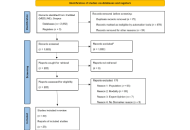
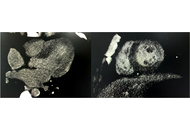
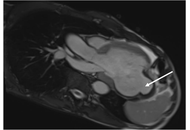


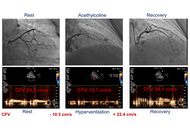
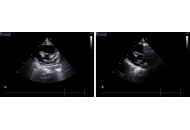
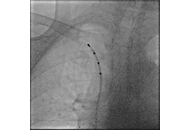
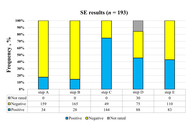
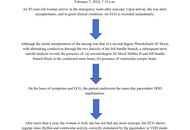
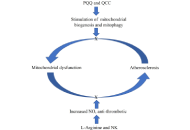
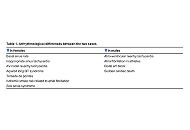
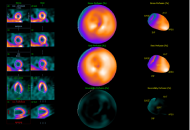
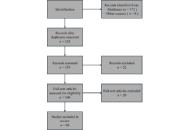
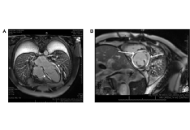



Aim:
Pulmonary vein isolation (PVI) is a widely accepted and effective treatment for atrial fibrillation (AF). Even though success rates have been climbing, some patients experience AF recurrence after ablation. This study aimed to identify predictors of AF recurrence, with a focus on the potential role of premature atrial contractions (PAC).
Methods:
A retrospective single-center analysis was conducted on 185 patients with AF who underwent primo PVI at a single center between 07/2014 and 01/2017. Patients underwent AF ablation using radiofrequency ablation (n = 61), by the CARTO (n = 50) and EnSite (n = 11) mapping systems, and the endoscopic laser balloon (n = 124). Exclusion criteria were combined procedures or the absence of a 24-hour Holter recording three months post-ablation. The primary endpoint was freedom from atrial arrhythmia 12 months after ablation with an application of a 90-day blanking period.
Results:
Survival analysis revealed a significant difference in AF recurrence rates between low and high PAC burden groups (log-rank test, p = 0.004). ROC-analysis identified an optimal PAC burden cut-off of 57 PAC’s over 24 hours (AUC 0.69). This association remained significant in multivariable Cox proportional hazards analysis, with a hazard ratio of 3.38 (p = 0.021).
Conclusions:
PAC burden measured on 24-hour Holter monitoring at three months proved to be an independent predictor of AF recurrence following PVI. Multivariable analysis confirmed a significant hazard ratio of 3.38 for AF recurrence within one year. An optimal predictive threshold of 57 PAC demonstrated high negative predictive value for AF recurrence.
Aim:
Pulmonary vein isolation (PVI) is a widely accepted and effective treatment for atrial fibrillation (AF). Even though success rates have been climbing, some patients experience AF recurrence after ablation. This study aimed to identify predictors of AF recurrence, with a focus on the potential role of premature atrial contractions (PAC).
Methods:
A retrospective single-center analysis was conducted on 185 patients with AF who underwent primo PVI at a single center between 07/2014 and 01/2017. Patients underwent AF ablation using radiofrequency ablation (n = 61), by the CARTO (n = 50) and EnSite (n = 11) mapping systems, and the endoscopic laser balloon (n = 124). Exclusion criteria were combined procedures or the absence of a 24-hour Holter recording three months post-ablation. The primary endpoint was freedom from atrial arrhythmia 12 months after ablation with an application of a 90-day blanking period.
Results:
Survival analysis revealed a significant difference in AF recurrence rates between low and high PAC burden groups (log-rank test, p = 0.004). ROC-analysis identified an optimal PAC burden cut-off of 57 PAC’s over 24 hours (AUC 0.69). This association remained significant in multivariable Cox proportional hazards analysis, with a hazard ratio of 3.38 (p = 0.021).
Conclusions:
PAC burden measured on 24-hour Holter monitoring at three months proved to be an independent predictor of AF recurrence following PVI. Multivariable analysis confirmed a significant hazard ratio of 3.38 for AF recurrence within one year. An optimal predictive threshold of 57 PAC demonstrated high negative predictive value for AF recurrence.
DOI: https://doi.org/10.37349/ec.2025.101281

Pulmonary congestion and coronary microvascular dysfunction are central to hemodynamic adaptation before and after transcatheter aortic valve replacement (TAVR). This perspective proposes an exploratory, physiology-anchored framework that integrates lung ultrasound (LUS) and transthoracic Doppler of the left anterior descending artery (LAD) to track these domains on the same bedside platform. A concise anterior four-site LUS sampling captures early, posture- and stress-dependent interstitial congestion, while LAD Doppler provides a non-invasive window on resting diastolic coronary flow velocity (CFV) and CFV reserve (CFVR). In severe aortic stenosis, valve unloading with TAVR typically reduces filling pressures and restores diastolic coronary flow, though CFV and CFVR responses vary with the balance between myocardial oxygen demand and improved hyperemia. Interpreting these signals alongside standard echocardiographic indices (E/e’, LAVI, SPAP, and Doppler velocity index) ensures physiological coherence and avoids misattribution. Rather than focusing on numeric thresholds, this approach emphasizes trajectories—how B-lines, CFV, and CFVR evolve from baseline to post-TAVR follow-up. Concordant improvement supports decongestion and microvascular recovery, whereas discordance prompts investigation of right-sided or extra-cardiac mechanisms. Readily implemented with existing echocardiographic equipment, the combined LUS-LAD strategy offers a scalable, hypothesis-generating tool to explore pulmonary-coronary interactions, guide decongestive and anti-ischemic therapy, and inform future feasibility and reproducibility studies in the TAVR population.
Pulmonary congestion and coronary microvascular dysfunction are central to hemodynamic adaptation before and after transcatheter aortic valve replacement (TAVR). This perspective proposes an exploratory, physiology-anchored framework that integrates lung ultrasound (LUS) and transthoracic Doppler of the left anterior descending artery (LAD) to track these domains on the same bedside platform. A concise anterior four-site LUS sampling captures early, posture- and stress-dependent interstitial congestion, while LAD Doppler provides a non-invasive window on resting diastolic coronary flow velocity (CFV) and CFV reserve (CFVR). In severe aortic stenosis, valve unloading with TAVR typically reduces filling pressures and restores diastolic coronary flow, though CFV and CFVR responses vary with the balance between myocardial oxygen demand and improved hyperemia. Interpreting these signals alongside standard echocardiographic indices (E/e’, LAVI, SPAP, and Doppler velocity index) ensures physiological coherence and avoids misattribution. Rather than focusing on numeric thresholds, this approach emphasizes trajectories—how B-lines, CFV, and CFVR evolve from baseline to post-TAVR follow-up. Concordant improvement supports decongestion and microvascular recovery, whereas discordance prompts investigation of right-sided or extra-cardiac mechanisms. Readily implemented with existing echocardiographic equipment, the combined LUS-LAD strategy offers a scalable, hypothesis-generating tool to explore pulmonary-coronary interactions, guide decongestive and anti-ischemic therapy, and inform future feasibility and reproducibility studies in the TAVR population.
DOI: https://doi.org/10.37349/ec.2025.101280

Cardiovascular aging is characterized by progressive endothelial dysfunction and arterial stiffening, two interrelated processes underlying the increased risk of hypertension, coronary artery disease, heart failure, and atrial fibrillation in older individuals. Endothelial dysfunction results from reduced nitric oxide bioavailability, increased oxidative stress, chronic low-grade inflammation, and accumulation of senescent endothelial cells that secrete pro-inflammatory mediators. In parallel, structural alterations of the vascular wall, including elastin fragmentation, collagen deposition, cross-linking by advanced glycation end products, vascular smooth muscle cell phenotypic switching, and calcification, lead to increased stiffness and impaired vascular compliance. These maladaptive changes reinforce one another, creating a vicious cycle in which dysfunctional endothelium accelerates stiffening, while mechanical alterations in turn amplify endothelial injury. Molecular pathways involving NADPH oxidases, mitochondrial dysfunction, NF-κB, JAK/STAT, AMPK, mTOR, sirtuins, and epigenetic regulators integrate oxidative, inflammatory, and metabolic signals that shape vascular aging. Clinically, endothelial dysfunction and vascular stiffness predict cardiovascular events independent of traditional risk factors and serve as emerging biomarkers of biological vascular age. Established therapies such as statins, renin-angiotensin system blockade, structured exercise, and dietary interventions improve vascular function, while novel approaches targeting senescence and redox imbalance are under investigation. Understanding these mechanisms provides opportunities to mitigate vascular aging and extend cardiovascular health span.
Cardiovascular aging is characterized by progressive endothelial dysfunction and arterial stiffening, two interrelated processes underlying the increased risk of hypertension, coronary artery disease, heart failure, and atrial fibrillation in older individuals. Endothelial dysfunction results from reduced nitric oxide bioavailability, increased oxidative stress, chronic low-grade inflammation, and accumulation of senescent endothelial cells that secrete pro-inflammatory mediators. In parallel, structural alterations of the vascular wall, including elastin fragmentation, collagen deposition, cross-linking by advanced glycation end products, vascular smooth muscle cell phenotypic switching, and calcification, lead to increased stiffness and impaired vascular compliance. These maladaptive changes reinforce one another, creating a vicious cycle in which dysfunctional endothelium accelerates stiffening, while mechanical alterations in turn amplify endothelial injury. Molecular pathways involving NADPH oxidases, mitochondrial dysfunction, NF-κB, JAK/STAT, AMPK, mTOR, sirtuins, and epigenetic regulators integrate oxidative, inflammatory, and metabolic signals that shape vascular aging. Clinically, endothelial dysfunction and vascular stiffness predict cardiovascular events independent of traditional risk factors and serve as emerging biomarkers of biological vascular age. Established therapies such as statins, renin-angiotensin system blockade, structured exercise, and dietary interventions improve vascular function, while novel approaches targeting senescence and redox imbalance are under investigation. Understanding these mechanisms provides opportunities to mitigate vascular aging and extend cardiovascular health span.
DOI: https://doi.org/10.37349/ec.2025.101279
This article belongs to the special issue Molecular Mechanisms of Cardiovascular Aging

Background:
Cardiac computed tomography (CT) has evolved from an anatomic test to a platform that quantifies functional, inflammatory, and tissue-characterization biomarkers. We synthesized evidence on the diagnostic and prognostic value of CT-based biomarkers.
Methods:
Systematic review of 29 human studies (2015–2025) appraising low-attenuation plaque (LAP), perivascular fat attenuation index (FAI/PCAT), total/non-calcified plaque burden, epicardial adipose tissue, CT-derived fractional flow reserve (FFR-CT), and CT myocardial perfusion. Study quality was assessed with risk of bias (RoB) 2.0, Newcastle-Ottawa Scale (NOS), and AMSTAR 2.
Results:
CT biomarkers extended risk assessment beyond stenosis severity. LAP burden > 4% predicted myocardial infarction (MI) [hazard ratio (HR) 4.65; 95% CI 2.06–10.5] and per-doubling LAP predicted MI (HR 1.60; 95% CI 1.10–2.34). Perivascular FAI/PCAT showed independent prognostic value: high FAI was associated with ~2-fold higher cardiac mortality (derivation HR 2.15, validation HR 2.06), and RCA PCAT ≥ −70.5 Hounsfield unit (HU) predicted MI (HR 2.45) with additive risk when combined with high-risk plaque (HRP) features (reported up to ~6-fold vs. reference). FFR-CT achieved up to 81% diagnostic accuracy (sensitivity ~86%, specificity ~79%) vs. invasive FFR, improving specificity over CTA alone. Emerging metrics (e.g., total plaque volume, CT perfusion) demonstrated incremental discrimination in selected cohorts, though standardization remains variable.
Discussion:
CT-based biomarkers provide measurable diagnostic and prognostic information on coronary anatomy, function, inflammation, and tissue health. Priorities include standardized acquisition/analysis, multicenter validation, and integration into decision pathways to optimize individualized risk stratification and therapy.
Background:
Cardiac computed tomography (CT) has evolved from an anatomic test to a platform that quantifies functional, inflammatory, and tissue-characterization biomarkers. We synthesized evidence on the diagnostic and prognostic value of CT-based biomarkers.
Methods:
Systematic review of 29 human studies (2015–2025) appraising low-attenuation plaque (LAP), perivascular fat attenuation index (FAI/PCAT), total/non-calcified plaque burden, epicardial adipose tissue, CT-derived fractional flow reserve (FFR-CT), and CT myocardial perfusion. Study quality was assessed with risk of bias (RoB) 2.0, Newcastle-Ottawa Scale (NOS), and AMSTAR 2.
Results:
CT biomarkers extended risk assessment beyond stenosis severity. LAP burden > 4% predicted myocardial infarction (MI) [hazard ratio (HR) 4.65; 95% CI 2.06–10.5] and per-doubling LAP predicted MI (HR 1.60; 95% CI 1.10–2.34). Perivascular FAI/PCAT showed independent prognostic value: high FAI was associated with ~2-fold higher cardiac mortality (derivation HR 2.15, validation HR 2.06), and RCA PCAT ≥ −70.5 Hounsfield unit (HU) predicted MI (HR 2.45) with additive risk when combined with high-risk plaque (HRP) features (reported up to ~6-fold vs. reference). FFR-CT achieved up to 81% diagnostic accuracy (sensitivity ~86%, specificity ~79%) vs. invasive FFR, improving specificity over CTA alone. Emerging metrics (e.g., total plaque volume, CT perfusion) demonstrated incremental discrimination in selected cohorts, though standardization remains variable.
Discussion:
CT-based biomarkers provide measurable diagnostic and prognostic information on coronary anatomy, function, inflammation, and tissue health. Priorities include standardized acquisition/analysis, multicenter validation, and integration into decision pathways to optimize individualized risk stratification and therapy.
DOI: https://doi.org/10.37349/ec.2025.101278

The diagnosis of acute myocarditis requires the exclusion of coronary artery disease (CAD). Coronary CTA (computed tomography angiography) is usually used to evaluate the coronary arteries in young patients. However, the use of coronary CTA for the diagnosis of myocarditis has been rarely reported. Here we present a Han male clinical myocarditis patient who was 18 years old, had a focus of enhancement in the subcardia, and predominantly involving the lateral wall of the left ventricle with iodinated contrast in coronary CTA. The patient was diagnosed with myocarditis. Immunoglobulin, vitamin C antioxidant, and myocardial nutrition were given to the patient for treatment. During follow-up, the patient’s myocardial enzymes gradually decreased to normal, and the original symptoms disappeared. As a non-invasive rapid examination method that can evaluate coronary artery and myocardial lesions at the same time, the utility of myocardial delayed enhancement on CTA may warrant further investigation.
The diagnosis of acute myocarditis requires the exclusion of coronary artery disease (CAD). Coronary CTA (computed tomography angiography) is usually used to evaluate the coronary arteries in young patients. However, the use of coronary CTA for the diagnosis of myocarditis has been rarely reported. Here we present a Han male clinical myocarditis patient who was 18 years old, had a focus of enhancement in the subcardia, and predominantly involving the lateral wall of the left ventricle with iodinated contrast in coronary CTA. The patient was diagnosed with myocarditis. Immunoglobulin, vitamin C antioxidant, and myocardial nutrition were given to the patient for treatment. During follow-up, the patient’s myocardial enzymes gradually decreased to normal, and the original symptoms disappeared. As a non-invasive rapid examination method that can evaluate coronary artery and myocardial lesions at the same time, the utility of myocardial delayed enhancement on CTA may warrant further investigation.
DOI: https://doi.org/10.37349/ec.2025.101277

A left ventricular pseudoaneurysm typically occurs as a result of myocardial infarction, blunt chest trauma, or cardiac surgery (typically coronary artery bypass grafting or mitral valve replacement). Pseudoaneurysms form due to left ventricular free wall rupture that is contained by the pericardium, not the myocardial wall, as is the case with a true aneurysm. Pseudoaneurysms have the tendency to expand rapidly as opposed to true aneurysms due to the weakness of the pericardium or fibrous tissue in comparison to myocardial tissue. This case presents a 63-year-old male found to have a very large left ventricular pseudoaneurysm measuring 8 × 7 × 5 cm. The vast majority of left ventricular pseudoaneurysms enlarge with worsening symptomatology and eventual rupture if not surgically repaired. Rarely, large pseudoaneurysms treated conservatively can lead to the gradual resolution of a patient’s symptoms and normalization of right ventricular function. The purpose of this case report is to describe the clinical course and outcomes of a patient with a large left ventricular pseudoaneurysm managed conservatively, thereby contributing to the limited medical data regarding the prognosis and long-term outcomes in this high-risk population.
A left ventricular pseudoaneurysm typically occurs as a result of myocardial infarction, blunt chest trauma, or cardiac surgery (typically coronary artery bypass grafting or mitral valve replacement). Pseudoaneurysms form due to left ventricular free wall rupture that is contained by the pericardium, not the myocardial wall, as is the case with a true aneurysm. Pseudoaneurysms have the tendency to expand rapidly as opposed to true aneurysms due to the weakness of the pericardium or fibrous tissue in comparison to myocardial tissue. This case presents a 63-year-old male found to have a very large left ventricular pseudoaneurysm measuring 8 × 7 × 5 cm. The vast majority of left ventricular pseudoaneurysms enlarge with worsening symptomatology and eventual rupture if not surgically repaired. Rarely, large pseudoaneurysms treated conservatively can lead to the gradual resolution of a patient’s symptoms and normalization of right ventricular function. The purpose of this case report is to describe the clinical course and outcomes of a patient with a large left ventricular pseudoaneurysm managed conservatively, thereby contributing to the limited medical data regarding the prognosis and long-term outcomes in this high-risk population.
DOI: https://doi.org/10.37349/ec.2025.101276

Ischemic heart disease (IHD) is a leading cause of morbidity and mortality worldwide, highlighting the necessity for better diagnostic modalities. Artificial intelligence (AI) and machine learning (ML) are increasingly being used with multimodal cardiovascular diagnostic testing to provide standardized and reproducible assessment methodologies that have been shown to detect subtle signals beyond human recognition. This state-of-the-art review will summarize the various applications of AI across key modalities: describing its use in electrocardiography to risk-stratify patients; in coronary computed tomography angiography (CCTA) for quantitative plaque and stenosis measurements as well as measuring fractional flow reserve (FFR) derived from imaging; in cardiac magnetic resonance imaging (MRI) to automatically segment cardiac chambers and characterize tissue; and in intracoronary imaging [specifically intravascular ultrasound (IVUS) and optical coherence tomography (OCT)], where automation is evolving. We will also discuss combining these sources of data through clinical decision support systems (CDSS) that can enhance the comprehensive evaluation of IHD. We anticipate several issues for implementation, including validation, regulation, transparency, and clinical integration. Overall, AI can help reduce the number of time-consuming manual measurements used to augment quantitative features of an assessment and improve physiology-based decision-making. However, there were marked differences in performance based on the task and dataset, and AI was not always better than the human experts. Ultimately, AI must be validated prospectively, must be generalizable, and reported transparently for safe adoption in IHD care globally.
Ischemic heart disease (IHD) is a leading cause of morbidity and mortality worldwide, highlighting the necessity for better diagnostic modalities. Artificial intelligence (AI) and machine learning (ML) are increasingly being used with multimodal cardiovascular diagnostic testing to provide standardized and reproducible assessment methodologies that have been shown to detect subtle signals beyond human recognition. This state-of-the-art review will summarize the various applications of AI across key modalities: describing its use in electrocardiography to risk-stratify patients; in coronary computed tomography angiography (CCTA) for quantitative plaque and stenosis measurements as well as measuring fractional flow reserve (FFR) derived from imaging; in cardiac magnetic resonance imaging (MRI) to automatically segment cardiac chambers and characterize tissue; and in intracoronary imaging [specifically intravascular ultrasound (IVUS) and optical coherence tomography (OCT)], where automation is evolving. We will also discuss combining these sources of data through clinical decision support systems (CDSS) that can enhance the comprehensive evaluation of IHD. We anticipate several issues for implementation, including validation, regulation, transparency, and clinical integration. Overall, AI can help reduce the number of time-consuming manual measurements used to augment quantitative features of an assessment and improve physiology-based decision-making. However, there were marked differences in performance based on the task and dataset, and AI was not always better than the human experts. Ultimately, AI must be validated prospectively, must be generalizable, and reported transparently for safe adoption in IHD care globally.
DOI: https://doi.org/10.37349/ec.2025.101275
This article belongs to the special issue Multimodality Imaging in Ischemic Heart Disease

Tricuspid valve disorders (TVDs) have historically been underrecognized by clinicians. However, recent years have seen increasing awareness of their clinical impact. This mini-review aims to briefly highlight some questions regarding TVDs, such as Review of tricuspid valve disorders, Decoding its trends, The gender and racial divide, Breaking barriers, Where you live matters, Surgery vs. minimally invasive options, Bridging the gap, and the underappreciated significance of TVDs and why they’re becoming a growing concern in the U.S. There is a significant change in perception of the tricuspid valve—from being the “forgotten valve” to being an important area of focus in cardiology as well as clinical medicine in general. With the aid of advanced imaging methods like echocardiography, CT, and MRI that show a clear and three-dimensional view of the tricuspid valve, there is a better understanding of both the prevalence and diagnostic precision of TVDs. Advancements involving more efficient and optimally timed treatment strategies are also occurring. Although medical and surgical approaches are still in use, developments such as transcatheter tricuspid valve interventions (TTVIs) are promising, particularly for high-risk patients with minimal improvement with surgical treatment. TVDs, especially tricuspid regurgitation, have gained widespread attention in the medical and research community, resulting in improved and evolving diagnostic and therapeutic progress to improve patient outcomes.
Tricuspid valve disorders (TVDs) have historically been underrecognized by clinicians. However, recent years have seen increasing awareness of their clinical impact. This mini-review aims to briefly highlight some questions regarding TVDs, such as Review of tricuspid valve disorders, Decoding its trends, The gender and racial divide, Breaking barriers, Where you live matters, Surgery vs. minimally invasive options, Bridging the gap, and the underappreciated significance of TVDs and why they’re becoming a growing concern in the U.S. There is a significant change in perception of the tricuspid valve—from being the “forgotten valve” to being an important area of focus in cardiology as well as clinical medicine in general. With the aid of advanced imaging methods like echocardiography, CT, and MRI that show a clear and three-dimensional view of the tricuspid valve, there is a better understanding of both the prevalence and diagnostic precision of TVDs. Advancements involving more efficient and optimally timed treatment strategies are also occurring. Although medical and surgical approaches are still in use, developments such as transcatheter tricuspid valve interventions (TTVIs) are promising, particularly for high-risk patients with minimal improvement with surgical treatment. TVDs, especially tricuspid regurgitation, have gained widespread attention in the medical and research community, resulting in improved and evolving diagnostic and therapeutic progress to improve patient outcomes.
DOI: https://doi.org/10.37349/ec.2025.101274

We report the case of a 58-year-old woman who developed typical chest pain following intravaginal administration of misoprostol, used routinely as a premedication before a hysteroscopy. Misoprostol is a synthetic prostaglandin E1 analogue widely employed for cervical softening and the medical management of an incomplete abortion, and is generally considered safe. The chest pain was accompanied by transient, severe ST-segment elevation (up to 6 mm) in the inferior and inferolateral electrocardiogram (ECG) leads, which resolved promptly after sublingual nitrate administration. A hyperventilation test (5 minutes at 30 breaths per minute) demonstrated a paradoxical reduction in peak diastolic flow velocity in the mid-to-distal left anterior descending coronary artery. Invasive coronary angiography showed smooth, angiographically normal coronary arteries, but provocation with intracoronary acetylcholine induced complete vasospasm of the left circumflex artery. This case underscores the importance of recognizing vasospastic angina even in non-cardiology settings. It highlights the value of targeted noninvasive and invasive diagnostic testing to confirm this often overlooked, underdiagnosed, and undertreated condition.
We report the case of a 58-year-old woman who developed typical chest pain following intravaginal administration of misoprostol, used routinely as a premedication before a hysteroscopy. Misoprostol is a synthetic prostaglandin E1 analogue widely employed for cervical softening and the medical management of an incomplete abortion, and is generally considered safe. The chest pain was accompanied by transient, severe ST-segment elevation (up to 6 mm) in the inferior and inferolateral electrocardiogram (ECG) leads, which resolved promptly after sublingual nitrate administration. A hyperventilation test (5 minutes at 30 breaths per minute) demonstrated a paradoxical reduction in peak diastolic flow velocity in the mid-to-distal left anterior descending coronary artery. Invasive coronary angiography showed smooth, angiographically normal coronary arteries, but provocation with intracoronary acetylcholine induced complete vasospasm of the left circumflex artery. This case underscores the importance of recognizing vasospastic angina even in non-cardiology settings. It highlights the value of targeted noninvasive and invasive diagnostic testing to confirm this often overlooked, underdiagnosed, and undertreated condition.
DOI: https://doi.org/10.37349/ec.2025.101273

Resistant Kawasaki has been associated with the aggressive development of large coronary aneurysms, despite prompt treatment. In this paper, we present an infant who presented with resistant Kawasaki. Although initially he seemed to defervesce after the initial administration of intravenous immunoglobulin, he developed a new onset of fever, requiring a repeat dose of immunoglobulin. Coronary aneurysms developed rapidly, necessitating a second dose of immunoglobulins and second-line treatments such as anakinra and infliximab. High titers of COVID-19 antibodies have been a confounding factor in the management of that child, as the alternative diagnosis of multisystem inflammatory syndrome in children (MIS-C) was considered. Finally, the clinical and laboratory values were more in keeping with MIS-C.
Resistant Kawasaki has been associated with the aggressive development of large coronary aneurysms, despite prompt treatment. In this paper, we present an infant who presented with resistant Kawasaki. Although initially he seemed to defervesce after the initial administration of intravenous immunoglobulin, he developed a new onset of fever, requiring a repeat dose of immunoglobulin. Coronary aneurysms developed rapidly, necessitating a second dose of immunoglobulins and second-line treatments such as anakinra and infliximab. High titers of COVID-19 antibodies have been a confounding factor in the management of that child, as the alternative diagnosis of multisystem inflammatory syndrome in children (MIS-C) was considered. Finally, the clinical and laboratory values were more in keeping with MIS-C.
DOI: https://doi.org/10.37349/ec.2025.101271

Phrenic nerve palsy (PNP) is a recognized complication of cryoballoon ablation (CBA) for atrial fibrillation (AF), particularly during the ablation of the right superior pulmonary vein (RSPV). We report the case of an 80-year-old female with a history of hypertension, who was admitted for CBA of paroxysmal AF. Despite optimal medical treatment with amiodarone, the patient experienced recurrent episodes of AF, prompting the decision to proceed with CBA. During the procedure, while isolating the RSPV, diaphragmatic movement was significantly weakened after 92 seconds of cryoablation at a temperature of –52°C. Immediate cessation of the procedure and intravenous methylprednisolone were administered, resulting in partial recovery of diaphragmatic movement. However, when the procedure resumed, diaphragmatic movement once again diminished, and despite further steroid treatment, the movement did not recover by discharge. The patient remained asymptomatic with stable oxygen saturation, and no respiratory distress was noted. At a six-month follow-up, the patient reported no symptoms of chest tightness or shortness of breath, and her general condition remained stable, although diaphragmatic movement had not fully recovered, indicating partial functional compensation. This case underscores the importance of continuous phrenic nerve monitoring during CBA, early detection of complications, and appropriate management to prevent irreversible injury, highlighting the need for careful procedural planning and postoperative follow-up in elderly patients with comorbidities.
Phrenic nerve palsy (PNP) is a recognized complication of cryoballoon ablation (CBA) for atrial fibrillation (AF), particularly during the ablation of the right superior pulmonary vein (RSPV). We report the case of an 80-year-old female with a history of hypertension, who was admitted for CBA of paroxysmal AF. Despite optimal medical treatment with amiodarone, the patient experienced recurrent episodes of AF, prompting the decision to proceed with CBA. During the procedure, while isolating the RSPV, diaphragmatic movement was significantly weakened after 92 seconds of cryoablation at a temperature of –52°C. Immediate cessation of the procedure and intravenous methylprednisolone were administered, resulting in partial recovery of diaphragmatic movement. However, when the procedure resumed, diaphragmatic movement once again diminished, and despite further steroid treatment, the movement did not recover by discharge. The patient remained asymptomatic with stable oxygen saturation, and no respiratory distress was noted. At a six-month follow-up, the patient reported no symptoms of chest tightness or shortness of breath, and her general condition remained stable, although diaphragmatic movement had not fully recovered, indicating partial functional compensation. This case underscores the importance of continuous phrenic nerve monitoring during CBA, early detection of complications, and appropriate management to prevent irreversible injury, highlighting the need for careful procedural planning and postoperative follow-up in elderly patients with comorbidities.
DOI: https://doi.org/10.37349/ec.2025.101272

Aim:
To assess the incidence and predictors of hypertensive response to exercise (HRE) of blood pressure during stress echocardiography (SE) with physical exercise in patients with known or probable coronary artery disease, and the effect of HRE on the results of the five-step SE.
Methods:
The single-center study included 193 patients who underwent ABCDE-SE. The incidence of HRE, predictors of its occurrence, and the relationship with positive results of the study protocol steps were investigated.
Results:
HRE was detected in 36.3% of patients (70 patients) and occurred more frequently during the bicycle ergometer test (p = 0.027). Patients with HRE had a significantly lower peak wall motion score index (p = 0.050) and achieved a preload ratio (p = 0.035), as well as higher left anterior descending coronary artery (LAD) blood flow velocity at rest and during exercise (p = 0.009 and p = 0.008, respectively). They also showed higher peak left ventricular (LV) contractile reserve and force (p = 0.002 and p = 0.006). Reduced contractile reserve was less common in patients with HRE (p = 0.013). Predictors related to HRE development were identified: history of LAD stenting, thickness of the LV posterior wall, LAD blood flow velocity, and normal LV force at rest (p = 0.006, p = 0.022, p = 0.004, and p = 0.003, respectively), as well as a positive step C (p = 0.005).
Conclusions:
The prevalence of HRE, its predictors, and the relationship with the ABCDE-SE results were revealed. The correlation between blood pressure response to exercise and SE steps, as well as its prognostic significance, needs further study.
Aim:
To assess the incidence and predictors of hypertensive response to exercise (HRE) of blood pressure during stress echocardiography (SE) with physical exercise in patients with known or probable coronary artery disease, and the effect of HRE on the results of the five-step SE.
Methods:
The single-center study included 193 patients who underwent ABCDE-SE. The incidence of HRE, predictors of its occurrence, and the relationship with positive results of the study protocol steps were investigated.
Results:
HRE was detected in 36.3% of patients (70 patients) and occurred more frequently during the bicycle ergometer test (p = 0.027). Patients with HRE had a significantly lower peak wall motion score index (p = 0.050) and achieved a preload ratio (p = 0.035), as well as higher left anterior descending coronary artery (LAD) blood flow velocity at rest and during exercise (p = 0.009 and p = 0.008, respectively). They also showed higher peak left ventricular (LV) contractile reserve and force (p = 0.002 and p = 0.006). Reduced contractile reserve was less common in patients with HRE (p = 0.013). Predictors related to HRE development were identified: history of LAD stenting, thickness of the LV posterior wall, LAD blood flow velocity, and normal LV force at rest (p = 0.006, p = 0.022, p = 0.004, and p = 0.003, respectively), as well as a positive step C (p = 0.005).
Conclusions:
The prevalence of HRE, its predictors, and the relationship with the ABCDE-SE results were revealed. The correlation between blood pressure response to exercise and SE steps, as well as its prognostic significance, needs further study.
DOI: https://doi.org/10.37349/ec.2025.101270

We present the electrocardiogram (ECG) of an elderly woman with Mobitz II atrioventricular (AV) block, left bundle branch block (LBBB), and ventricular ectopic activity. At first glance, the ECG may give the misleading impression of Wenckebach periodicity and raise the suspicion of intermittent left anterior fascicular block (LAFB) and left posterior fascicular block (LPFB), suggesting an apparent alternating conduction block in the main divisions of the LBB. This intriguing appearance prompted us to present the case.
We present the electrocardiogram (ECG) of an elderly woman with Mobitz II atrioventricular (AV) block, left bundle branch block (LBBB), and ventricular ectopic activity. At first glance, the ECG may give the misleading impression of Wenckebach periodicity and raise the suspicion of intermittent left anterior fascicular block (LAFB) and left posterior fascicular block (LPFB), suggesting an apparent alternating conduction block in the main divisions of the LBB. This intriguing appearance prompted us to present the case.
DOI: https://doi.org/10.37349/ec.2025.101269

Our cells and, therefore, our organism, need energy to function at their best, which is mainly produced by mitochondria. These intracellular organelles generate energy from food macromolecules across the Krebs cycle by oxidative phosphorylation. Energy is developed by converting adenosine triphosphate (ATP) to adenosine diphosphate (ADP). It is essential, for adequate mitochondrial energy production in the form of ATP, to have the right number of well-functioning mitochondria and the right amount of oxygen (O2) available. Unfortunately, the aging process and the chronic diseases that arise over the years are associated with a reduction in the number of mitochondria and their insufficient functioning. Among the chronic diseases related to significant damage of the arteries with a reduction in the supply of O2, there is atherosclerosis, where the process of atherothrombosis occurs. To keep our organs well-functioning despite aging, we must therefore protect our mitochondria and arteries. This can be achieved by intervening early in prevention with a lifestyle correction and diet integration with effective natural substances or, in some cases, with drugs. Among the many natural substances that have good scientific support, we have chosen four that have demonstrated benefits in the absence of side effects and that we know best: quercetin and pyrroloquinoline quinone to stimulate mitochondrial biogenesis and mitophagy, while L-arginine and nattokinase to protect the arteries from atherothrombosis.
Our cells and, therefore, our organism, need energy to function at their best, which is mainly produced by mitochondria. These intracellular organelles generate energy from food macromolecules across the Krebs cycle by oxidative phosphorylation. Energy is developed by converting adenosine triphosphate (ATP) to adenosine diphosphate (ADP). It is essential, for adequate mitochondrial energy production in the form of ATP, to have the right number of well-functioning mitochondria and the right amount of oxygen (O2) available. Unfortunately, the aging process and the chronic diseases that arise over the years are associated with a reduction in the number of mitochondria and their insufficient functioning. Among the chronic diseases related to significant damage of the arteries with a reduction in the supply of O2, there is atherosclerosis, where the process of atherothrombosis occurs. To keep our organs well-functioning despite aging, we must therefore protect our mitochondria and arteries. This can be achieved by intervening early in prevention with a lifestyle correction and diet integration with effective natural substances or, in some cases, with drugs. Among the many natural substances that have good scientific support, we have chosen four that have demonstrated benefits in the absence of side effects and that we know best: quercetin and pyrroloquinoline quinone to stimulate mitochondrial biogenesis and mitophagy, while L-arginine and nattokinase to protect the arteries from atherothrombosis.
DOI: https://doi.org/10.37349/ec.2025.101268

Scientific evidence seems to indicate that, in males, intense and prolonged endurance sport can favor the onset of atrial fibrillation. A plausible explanation may be the impact that intense endurance sports produce on the three vertices of Coumel’s triangle. However, genetics is probably also involved in translating this impact into an arrhythmic phenotype. On a management level, the first task of the cardiologist is to exclude the presence of structural heart disease, channelopathy, endocrine and/or electrolyte disorders, and substance use. As for the treatment of arrhythmia, the “CARE” paradigm proposed by the latest ESC guidelines should probably be accompanied by detraining, although this suggestion is often rejected by the athlete. Anticoagulant therapy, where indicated, must take into account the risk of trauma that the sport entails, even if the particular pharmacodynamics/pharmacokinetics of DOACs should allow training/competition to take place when the anticoagulant effect of the previous administration has completely or almost completely worn off.
Scientific evidence seems to indicate that, in males, intense and prolonged endurance sport can favor the onset of atrial fibrillation. A plausible explanation may be the impact that intense endurance sports produce on the three vertices of Coumel’s triangle. However, genetics is probably also involved in translating this impact into an arrhythmic phenotype. On a management level, the first task of the cardiologist is to exclude the presence of structural heart disease, channelopathy, endocrine and/or electrolyte disorders, and substance use. As for the treatment of arrhythmia, the “CARE” paradigm proposed by the latest ESC guidelines should probably be accompanied by detraining, although this suggestion is often rejected by the athlete. Anticoagulant therapy, where indicated, must take into account the risk of trauma that the sport entails, even if the particular pharmacodynamics/pharmacokinetics of DOACs should allow training/competition to take place when the anticoagulant effect of the previous administration has completely or almost completely worn off.
DOI: https://doi.org/10.37349/ec.2025.101267

We report a rare case of non-ischemic cardiomyopathy in a 62-year-old female with mucous membrane pemphigoid following rituximab therapy. The patient presented with dyspnea and chest pain, and cardiac evaluation-including transthoracic echocardiogram and nuclear medicine stress testing-revealed left ventricular dysfunction without evidence of ischemia. Given the temporal association and absence of other etiologies, rituximab was suspected as the causative agent. This case emphasizes the importance of recognizing the potential cardiotoxic effects of biological agents used in autoimmune disease management and supports the consideration of cardiac surveillance in at-risk patients receiving rituximab.
We report a rare case of non-ischemic cardiomyopathy in a 62-year-old female with mucous membrane pemphigoid following rituximab therapy. The patient presented with dyspnea and chest pain, and cardiac evaluation-including transthoracic echocardiogram and nuclear medicine stress testing-revealed left ventricular dysfunction without evidence of ischemia. Given the temporal association and absence of other etiologies, rituximab was suspected as the causative agent. This case emphasizes the importance of recognizing the potential cardiotoxic effects of biological agents used in autoimmune disease management and supports the consideration of cardiac surveillance in at-risk patients receiving rituximab.
DOI: https://doi.org/10.37349/ec.2025.101266

Fungal endocarditis (FE) is still an uncommon but devastating infection, especially when immunosuppression, prosthetic valve surgery, or prolonged health care is involved. Although being only responsible for 1–6% of infective endocarditis cases, the mortality rate is higher than 40–60% due to the time lag from diagnosis and therapeutic complexity. Etiology is led by Candida species, especially Candida albicans, followed by Aspergillus, and new pathogens like multidrug-resistant Candida auris are also seen. Non-C. albicans and the biofilm-forming species also add more complexity to the manageability. Diagnosis is challenging due to the high percentage of culture-negative cases, particularly for molds, requiring sophisticated investigations such as fungal biomarkers (β-D-glucan, galactomannan), molecular tests, and imaging studies such as 18F-FDG PET/CT (fluorine-18 fluorodeoxyglucose positron emission tomography/computed tomography). Early transesophageal echocardiography is crucial in the diagnosis of vegetations, whereas histopathology of resected non-cardiac tissue offers a definitive diagnosis. Treatment requires aggressive antifungal therapy, echinocandins, amphotericin B, or azoles, in conjunction with urgent valve surgery to reduce embolic risk and enhance survival. However, drug resistance, biofilm resistance, and patient comorbidities counteract the efficacy. Novel treatments such as rezafungin and ibrexafungerp are promising but have limited clinical hands-on evidence. Risk factors of immunosuppression, indwelling devices, and IV drug use imply a need for increased clinical suspicion in high-risk groups. Although there have been minor improvements in FE survival, the grim situation of FE persists, highlighting the importance of a multidisciplinary approach, early diagnosis, and tailored antifungal therapy to control this deadly infection.
Fungal endocarditis (FE) is still an uncommon but devastating infection, especially when immunosuppression, prosthetic valve surgery, or prolonged health care is involved. Although being only responsible for 1–6% of infective endocarditis cases, the mortality rate is higher than 40–60% due to the time lag from diagnosis and therapeutic complexity. Etiology is led by Candida species, especially Candida albicans, followed by Aspergillus, and new pathogens like multidrug-resistant Candida auris are also seen. Non-C. albicans and the biofilm-forming species also add more complexity to the manageability. Diagnosis is challenging due to the high percentage of culture-negative cases, particularly for molds, requiring sophisticated investigations such as fungal biomarkers (β-D-glucan, galactomannan), molecular tests, and imaging studies such as 18F-FDG PET/CT (fluorine-18 fluorodeoxyglucose positron emission tomography/computed tomography). Early transesophageal echocardiography is crucial in the diagnosis of vegetations, whereas histopathology of resected non-cardiac tissue offers a definitive diagnosis. Treatment requires aggressive antifungal therapy, echinocandins, amphotericin B, or azoles, in conjunction with urgent valve surgery to reduce embolic risk and enhance survival. However, drug resistance, biofilm resistance, and patient comorbidities counteract the efficacy. Novel treatments such as rezafungin and ibrexafungerp are promising but have limited clinical hands-on evidence. Risk factors of immunosuppression, indwelling devices, and IV drug use imply a need for increased clinical suspicion in high-risk groups. Although there have been minor improvements in FE survival, the grim situation of FE persists, highlighting the importance of a multidisciplinary approach, early diagnosis, and tailored antifungal therapy to control this deadly infection.
DOI: https://doi.org/10.37349/ec.2025.101264

We aim to describe a unique case of a desmoplakin gene mutation with refractory ventricular arrhythmia and cardiomyopathy. We describe a 29-year-old man hospitalized for chest pain and cardiomyopathy, who subsequently developed ventricular arrhythmia that was refractory to multiple antiarrhythmic agents, ablation, immunotherapy, and sympathectomy. Diagnostic studies included coronary catheterization, cardiac MRI, and endomyocardial biopsy. He underwent placement of an Impella 5.5 temporary mechanical support device for multi-organ failure; eventually requiring a Heartmate 3 left ventricular assist device. This report details how cardiac MRI, endomyocardial biopsy, and genetic testing are crucial diagnostic modalities when assessing patients with refractory arrhythmias or myocarditis. Pathogenic variants in the desmoplakin gene can be associated with significant morbidity in patients and require multidisciplinary care from cardiology, electrophysiology, advanced heart failure, and cardiac surgery. Arrhythmogenic cardiomyopathies should be considered for patients suffering repeated episodes of myocarditis or refractory ventricular arrhythmias. We utilized various criteria of functional, electrocardiographic, arrhythmic, tissue characterization, and genetic findings to establish the diagnosis of arrhythmogenic cardiomyopathy, which will be discussed later in this paper.
We aim to describe a unique case of a desmoplakin gene mutation with refractory ventricular arrhythmia and cardiomyopathy. We describe a 29-year-old man hospitalized for chest pain and cardiomyopathy, who subsequently developed ventricular arrhythmia that was refractory to multiple antiarrhythmic agents, ablation, immunotherapy, and sympathectomy. Diagnostic studies included coronary catheterization, cardiac MRI, and endomyocardial biopsy. He underwent placement of an Impella 5.5 temporary mechanical support device for multi-organ failure; eventually requiring a Heartmate 3 left ventricular assist device. This report details how cardiac MRI, endomyocardial biopsy, and genetic testing are crucial diagnostic modalities when assessing patients with refractory arrhythmias or myocarditis. Pathogenic variants in the desmoplakin gene can be associated with significant morbidity in patients and require multidisciplinary care from cardiology, electrophysiology, advanced heart failure, and cardiac surgery. Arrhythmogenic cardiomyopathies should be considered for patients suffering repeated episodes of myocarditis or refractory ventricular arrhythmias. We utilized various criteria of functional, electrocardiographic, arrhythmic, tissue characterization, and genetic findings to establish the diagnosis of arrhythmogenic cardiomyopathy, which will be discussed later in this paper.
DOI: https://doi.org/10.37349/ec.2025.101265

We report the case of a 58-year-old patient with chronic ischemic syndrome who underwent dipyridamole stress echocardiography for the evaluation of chest pain. The stress test was negative with normal coronary flow velocity reserve, preserved chronotropic competence, and no inducible wall motion abnormalities. However, upon administration of aminophylline at the end of the test, the patient developed acute chest pain, ST-segment elevation, and severe apical wall motion abnormalities. These findings resolved with intravenous nitrates. Subsequent coronary angiography revealed a significant vasospastic stenosis in the left anterior descending artery superimposed on a mild organic stenosis of around 50% after intracoronary nitrates. The coronary stenosis was successfully treated with a drug-eluting stent. This case highlights the potential for vasospastic angina to be unmasked following vasodilator reversal, even after a negative stress echocardiography.
We report the case of a 58-year-old patient with chronic ischemic syndrome who underwent dipyridamole stress echocardiography for the evaluation of chest pain. The stress test was negative with normal coronary flow velocity reserve, preserved chronotropic competence, and no inducible wall motion abnormalities. However, upon administration of aminophylline at the end of the test, the patient developed acute chest pain, ST-segment elevation, and severe apical wall motion abnormalities. These findings resolved with intravenous nitrates. Subsequent coronary angiography revealed a significant vasospastic stenosis in the left anterior descending artery superimposed on a mild organic stenosis of around 50% after intracoronary nitrates. The coronary stenosis was successfully treated with a drug-eluting stent. This case highlights the potential for vasospastic angina to be unmasked following vasodilator reversal, even after a negative stress echocardiography.
DOI: https://doi.org/10.37349/ec.2025.101263

Peripartum cardiomyopathy (PPCM) is a rare condition characterized by heart failure secondary to left ventricular systolic dysfunction, occurring in women during the last trimester of pregnancy or within five months postpartum. Despite advancements in research, PPCM remains a life-threatening disorder associated with significant maternal morbidity and mortality. The primary clinical manifestations of PPCM result from heart failure due to impaired left ventricular systolic function. This article reviews the epidemiology, etiology, diagnostic criteria, management strategies, and outcomes of PPCM. Additionally, we present a case of a 34-year-old woman with PPCM who achieved full recovery within nine months, underscoring the importance of early recognition, prompt treatment, standardized medication, and regular follow-up.
Peripartum cardiomyopathy (PPCM) is a rare condition characterized by heart failure secondary to left ventricular systolic dysfunction, occurring in women during the last trimester of pregnancy or within five months postpartum. Despite advancements in research, PPCM remains a life-threatening disorder associated with significant maternal morbidity and mortality. The primary clinical manifestations of PPCM result from heart failure due to impaired left ventricular systolic function. This article reviews the epidemiology, etiology, diagnostic criteria, management strategies, and outcomes of PPCM. Additionally, we present a case of a 34-year-old woman with PPCM who achieved full recovery within nine months, underscoring the importance of early recognition, prompt treatment, standardized medication, and regular follow-up.
DOI: https://doi.org/10.37349/ec.2025.101262
This article belongs to the special issue Cardiovascular Risk for Mothers and Offspring Resulting from Complicated Pregnancy
 Previous
Previous